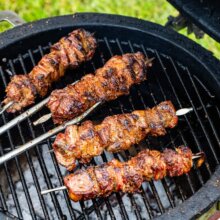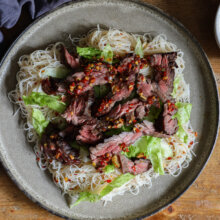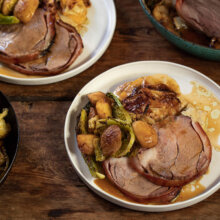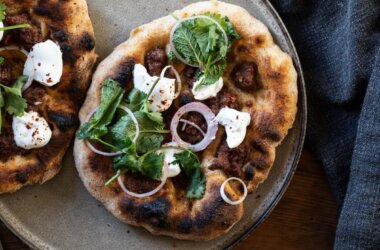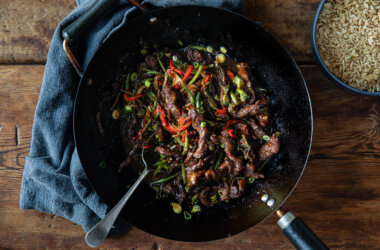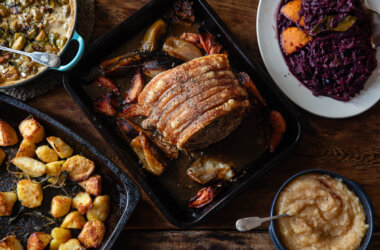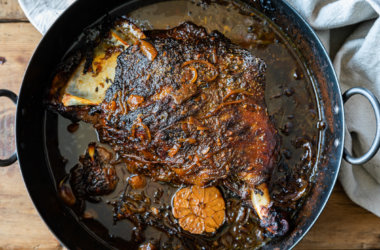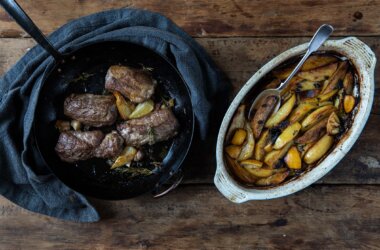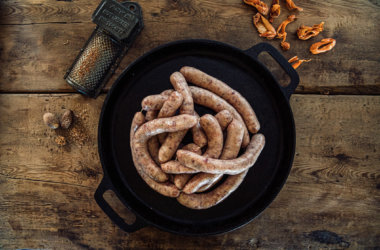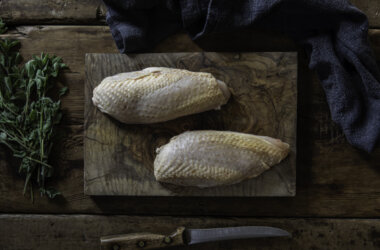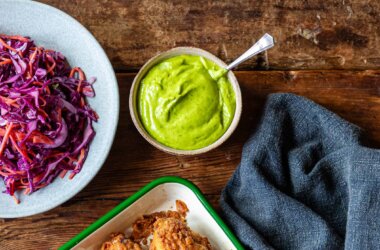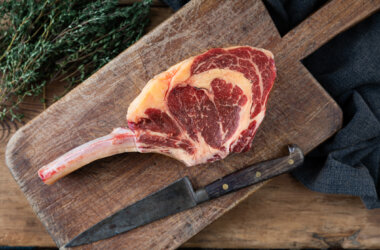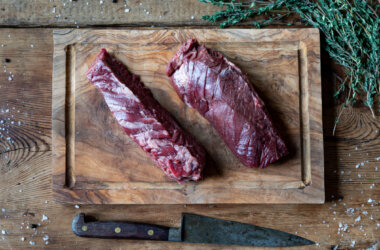Roast Venison Saddle Recipe with Braised Radicchio and Pickled Walnuts
It’s a testament to the pioneering team at Swaledale Butchers that a cut more often found in the hands of a chef can now find its way onto your dining table. Don’t let that put you off – embrace the opportunity to cook something truly special.
A saddle of venison is a stunning cut to prepare. The tender, rich loin meat is protected by a natural layer of fat during roasting, ensuring a perfect medium-rare finish with a deep, rich red throughout. It’s a dish that’s bound to impress and highlight the versatility of this heritage venison recipe.
The red wine-braised lentils are a classic accompaniment, a recipe worth having up your sleeve as they pair beautifully with a variety of meats. And let’s not forget the braised radicchio – an eye-opener that will leave you envious of the people of Northern Italy, who have been savouring its delights for generations. These thoughtfully paired flavours create a dish that feels both indulgent and grounded in culinary tradition.

Serves 6-8
Ingredients
For the Lentils:
For the Braised Radicchio:
For the Sauce:
Method
Preparing the Venison Saddle
- Start by removing the venison saddle from the fridge and its packaging. Allow it to come to room temperature, as this step ensures a more even cook and better texture.
- Preheat your oven to 160°C.
Making the Sauce
- Roast the Bones: Preheat your oven to 160°C. Place the beef bones in a roasting tray and roast for 30 minutes until golden and caramelised.
- Prepare the Vegetables: While the bones roast, heat 2 tablespoons of olive oil in a large pan over medium heat. Add the onions, carrots, garlic, and juniper berries. Cover with a lid and sweat the vegetables, stirring regularly, for about 20 minutes, or until they are soft and sweet.
- Combine Bones and Vegetables: Carefully transfer the roasted bones into the pan with the vegetables.
- De-glaze the Roasting Tray: Pour the red wine into the roasting tray and scrape up any browned bits. Tip this deglazed liquid into the pot with the bones and vegetables, then bring everything to a boil.
- Add Stock and Herbs: Once boiling, add the chicken stock, rosemary, and thyme. Bring back to a boil, then reduce to a gentle simmer and cook for about 1 hour.
- Strain and Reduce: After an hour, remove the pot from the heat and let it rest for 20 minutes. Strain the contents through a fine sieve, discarding the bones and vegetables. Return the strained liquid to the heat and simmer for another 45 minutes to 1 hour, or until the sauce reaches the desired consistency.
- Season and Finish: Taste the sauce and adjust the seasoning if necessary. Your sauce is now ready to accompany the venison saddle or any other dish you’ve prepared.
Preparing the Lentils
- Cook the Lardons: Heat 2 tablespoons of olive oil in a large, heavy-bottomed pan over medium heat. Add the smoked lardons and stir regularly, letting them brown and render their fat.
- Sweat the Vegetables: Once the lardons are browned and swimming in rendered fat, add the onions, carrots, garlic, celery, celeriac, and a generous pinch of salt. Cover with a lid and cook over low heat for about 20 minutes, stirring frequently, until the vegetables are soft and just starting to colour.
- Add the Lentils and Wine: Stir in the lentils and pour in the red wine. Bring to a boil, then reduce to a simmer and let the wine cook off for a couple of minutes.
- Simmer with Stock and Herbs: Add the chicken stock, bouquet garni, 3 more tablespoons of extra virgin olive oil, and another pinch of salt. Bring the mixture to a boil, then reduce to a gentle simmer. Cover with a lid and cook for about 45 minutes, stirring occasionally.
- Adjust Consistency: If the lentils start to look a little dry during cooking, add a splash more chicken stock to keep them moist.
This method ensures tender, flavour-packed lentils that make a perfect accompaniment to the venison saddle or other hearty dishes.
Cooking the Venison Saddle and Accompaniments
- Prepare the Venison: Season the venison saddle generously with salt. Heat a large pan over high heat. Once hot, reduce the heat to medium and add the venison. Brown it on all sides, rotating it every minute or so. If the pan becomes too hot, lower the heat to avoid scorching the fat. The goal is to achieve a nice colour while rendering some of the fat.
- Add Butter and Baste: Once the venison is browned all over, add a knob of butter to the pan and baste the joint thoroughly. Transfer the venison to the oven, either in the same pan or on an oven tray. Set a timer for 12 minutes.
- Check the Lentils: While the venison cooks, check the lentils. They should be soft and creamy but not mushy—avoid an al dente texture. Adjust the seasoning as needed, adding a splash of sherry or another good vinegar to balance the flavours.
- Baste and Rotate: When the timer goes off, remove the venison from the oven and baste it again. Rotate the joint so the side that was against the pan is now facing up. Baste thoroughly and return it to the oven for another 12 minutes.
- Cook the Radicchio: Quarter the radicchio and wash it well. Heat 3 tablespoons of extra virgin olive oil in a large frying pan over high heat. Add the garlic cloves, gently crushed with the back of a knife, and cook for 30 seconds to release their aroma. Add the radicchio with a generous pinch of salt and cook on high heat, stirring frequently, for about 10 minutes. Turn the heat down if it becomes too intense. Add the sherry vinegar and picked thyme, stir well, and adjust the seasoning if necessary.
- Final Baste and Test the Venison: After the second 12-minute segment, remove the venison from the oven and baste it again. Test the doneness by inserting a small knife into the centre of the joint, then gently pressing the knife against your lip. It should feel warm, just above body temperature, indicating it’s ready for a long rest. If it feels cold, return the venison to the oven in 4-minute intervals until warm.
- Rest the Venison: Allow the venison to rest in a warm place for at least 30 minutes.
- Reheat and Finish the Sauce: Reheat the prepared sauce gently. Slice the pickled walnuts into small “coins” and add them to the sauce along with a splash of their pickling liquor. Stir well to combine and ensure the sauce is hot before serving.
- Plate and Serve: Slice the rested venison, ensuring each plate is generously coated with the sauce and pickled walnut pieces. Serve alongside the creamy lentils and caramelised radicchio for a beautifully balanced and flavourful dish.
